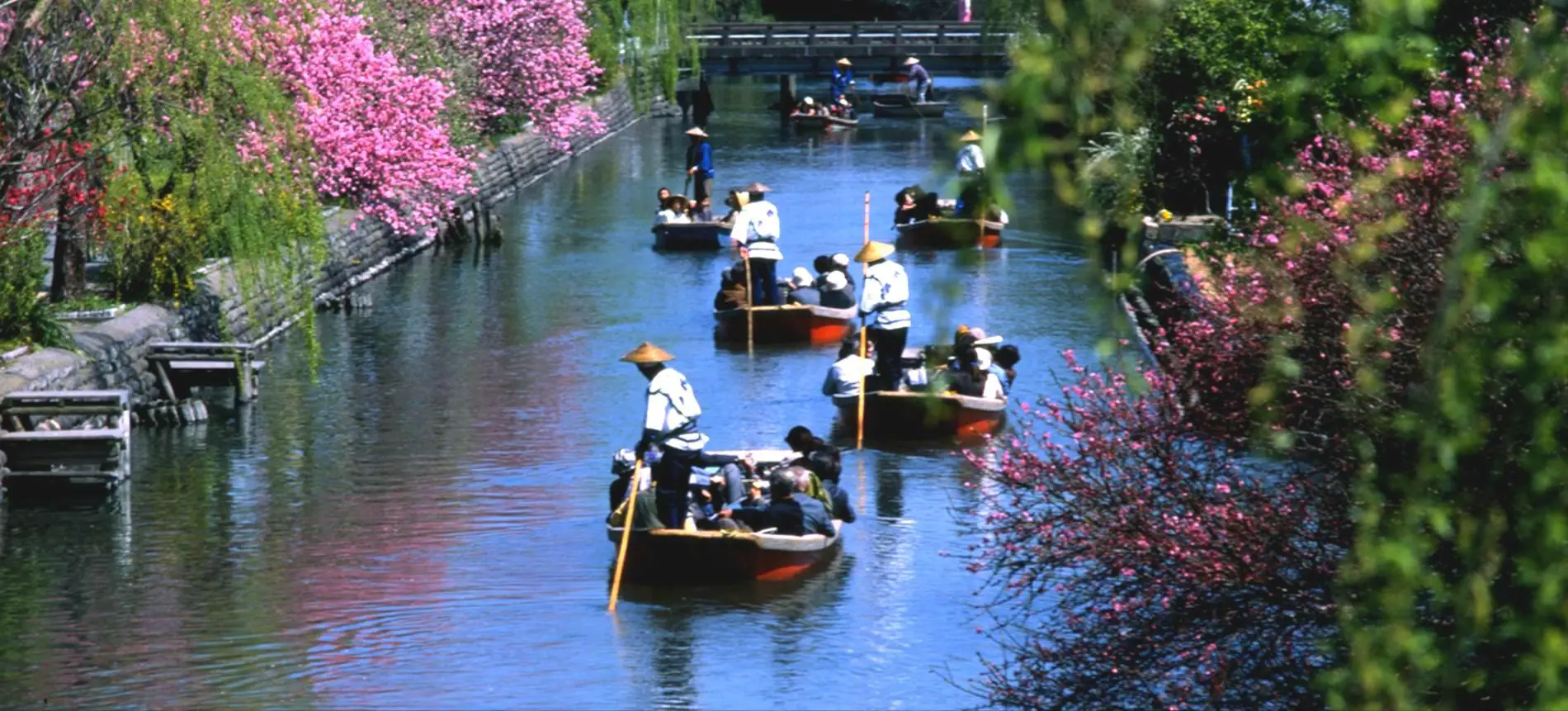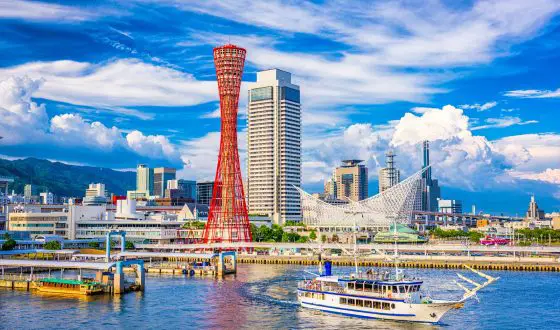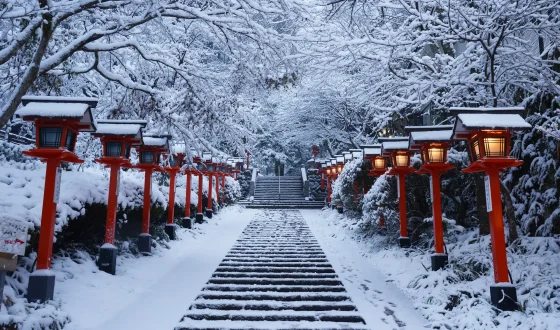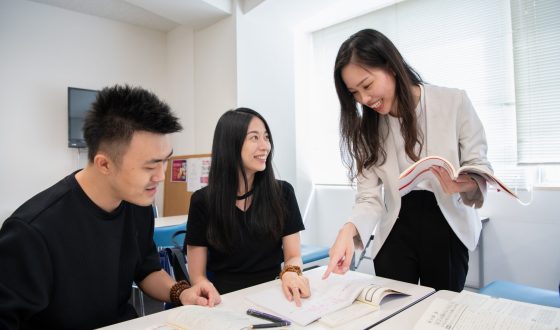10 Things to Do in Fukuoka – Unveiling Hidden Gems and Local Delights
Welcome to our blog, where we dive into the enchanting city of Fukuoka and uncover the top things to do in Fukuoka that will make your visit truly unforgettable. Situated on the northern coast of Kyushu Island in Japan, Fukuoka is a vibrant metropolis bursting with a unique blend of modernity and tradition.
In this comprehensive guide, we will take you on a virtual journey through Fukuoka’s rich cultural heritage, dynamic cityscape, and mouthwatering culinary scene. Whether you’re a history buff, a foodie, or an adventurer seeking new experiences, Fukuoka has something special in store for you.
So, pack your bags, prepare your taste buds, and get ready to embark on an extraordinary journey through Fukuoka’s captivating blend of history, culture, and vibrant city life. Let’s dive into the enchanting world of Fukuoka and discover the endless possibilities that await you.
Get ready to immerse yourself in the wonders of Fukuoka and create memories that will last a lifetime!
Fukuoka is A Captivating Destination
Fukuoka, a captivating city on the northern coast of Kyushu Island in Japan, boasts a remarkable blend of modernity and tradition. It seamlessly combines the fast-paced energy of a thriving metropolis with a deep-rooted appreciation for its cultural heritage.
On one hand, Fukuoka dazzles visitors with its modern skyline adorned with sleek skyscrapers, contemporary architectural marvels, and bustling shopping districts. Areas like Canal City Hakata and Tenjin Underground Shopping Mall offer a plethora of trendy boutiques, high-end brands, and entertainment options.
The city’s vibrant nightlife in Nakasu adds an extra touch of excitement, with its neon-lit streets, diverse dining establishments, and stylish bars and clubs. However, Fukuoka’s charm lies in its ability to maintain a strong connection to its traditional roots.
Amidst the modernity, you’ll discover pockets of history and culture that transport you back in time. Historic landmarks such as Fukuoka Castle and Kushida Shrine stand as testaments to the city’s rich heritage.
In Hakata Old Town, ancient buildings and narrow alleys invite you to explore its traditional ambiance and immerse yourself in the atmosphere of yesteryears. Fukuoka’s cultural institutions, such as the Asian Art Museum and Fukuoka City Museum, showcase an impressive collection of art and artifacts, offering glimpses into the region’s past.
It is in the harmonious coexistence of tradition and modernity that Fukuoka truly shines. You can witness this blend in various aspects of daily life, from the traditional rituals and ceremonies that continue to be practiced to the innovative fusion cuisine that infuses traditional flavors with contemporary techniques.
The city’s festivals and events epitomize this fusion, where age-old customs meet modern celebrations. The Hakata Gion Yamakasa festival, with its captivating floats and vibrant processions, brings together the spirit of tradition and community. During the Dontaku Port Festival, locals and visitors alike participate in lively parades and performances, celebrating both heritage and modern-day revelry.
Fukuoka’s unique blend of modernity and tradition creates a captivating tapestry that appeals to all kinds of travelers. It invites you to experience the excitement of a modern city while immersing yourself in the rich cultural heritage that defines the region.
Fukuoka is a destination where old and new seamlessly intertwine, offering a truly unforgettable experience that leaves a lasting impression on every visitor.
Historical and Cultural Exploration
Visit historical landmarks such as Fukuoka Castle and Kushida Shrine
Visiting historical landmarks is an essential part of exploring Fukuoka and immersing oneself in its rich cultural heritage. Two must-visit sites are Fukuoka Castle and Kushida Shrine, which offer a glimpse into the city’s storied past.
1. Fukuoka Castle
Fukuoka Castle, also known as Maizuru Castle, stands as a symbol of the city’s feudal history. Although the original castle was destroyed, the remaining ruins have been meticulously reconstructed to recreate its former grandeur.
As you wander through the castle grounds, you’ll be transported back in time, marveling at the stone walls, moats, and impressive gates. The panoramic views from the castle grounds provide a stunning perspective of the city, making it a favorite spot for both history enthusiasts and nature lovers.
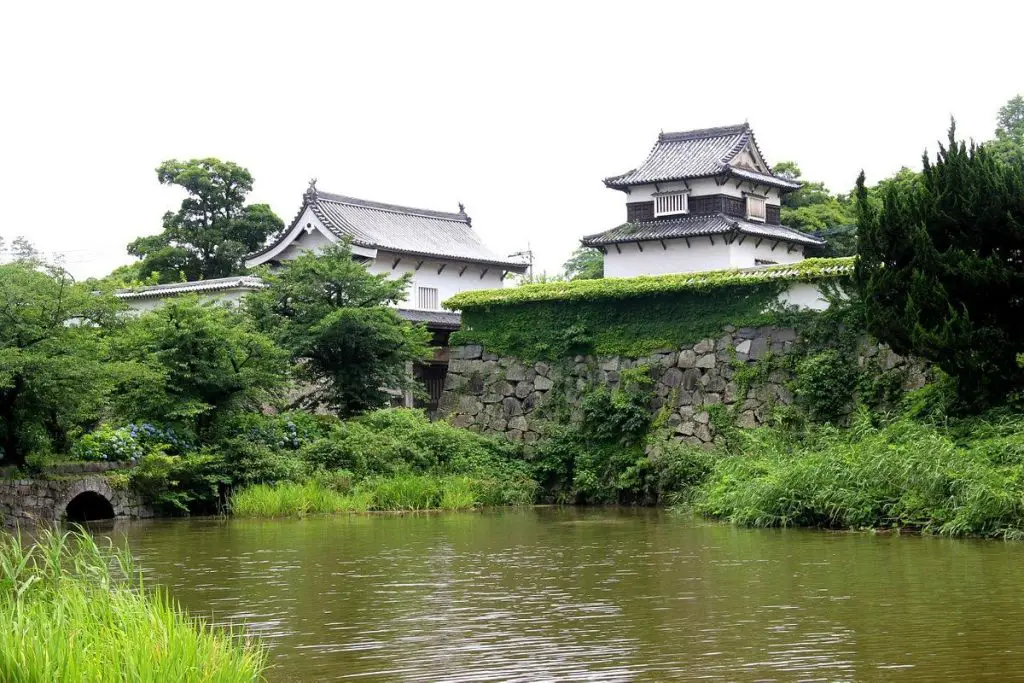
Fukuoka Castle, also known as Maizuru Castle, stands as a symbol of the city’s feudal history. (Source: Internet)
Price:
The entrance fee for Fukuoka Castle varies depending on the specific areas you wish to visit. As of my knowledge cutoff in September 2021, the fees are as follows:
- Castle Keep: 400 yen ∼ 2,82 USD (adults), 200 yen ∼ 1,41 USD (children)
- Outer Moat Area: Free admission
2. Kushida Shrine
Another iconic landmark is Kushida Shrine, one of Fukuoka’s oldest and most revered Shinto shrines. Stepping into its sacred precincts, you’ll be greeted by a serene atmosphere and an impressive display of traditional architecture.
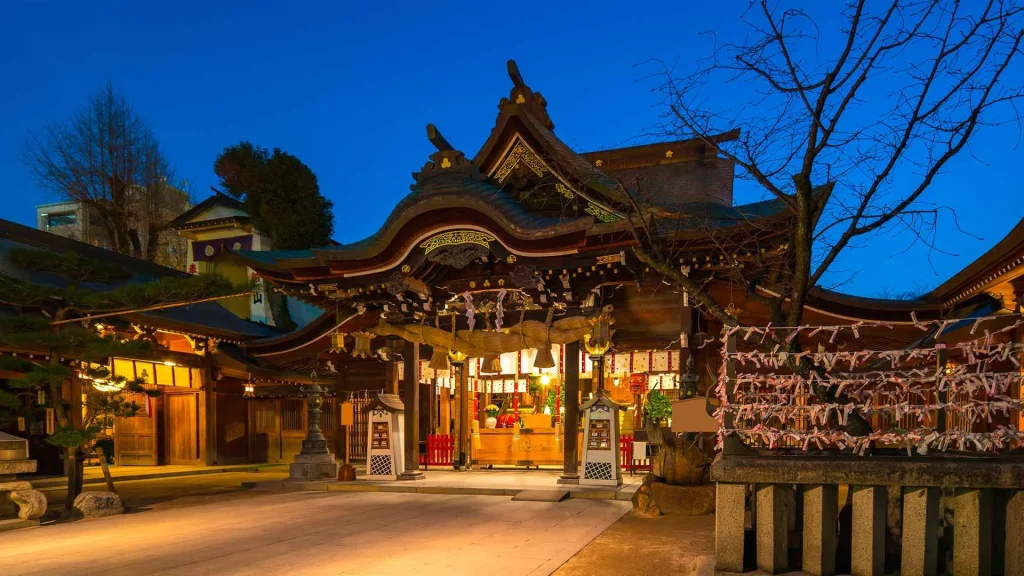
Another iconic landmark is Kushida Shrine, one of Fukuoka’s oldest and most revered Shinto shrines. (Source: Internet)
The shrine is dedicated to Amaterasu, the sun goddess, and houses various treasured artifacts and cultural relics. One of the most notable events held at Kushida Shrine is the Hakata Gion Yamakasa festival, where participants carry massive floats through the city streets in a celebration of tradition and community.
Price:
Kushida Shrine is generally open to the public for free. However, there may be additional charges for special events or access to specific areas within the shrine complex. These fees, if applicable, will be clearly indicated at the entrance or within the shrine grounds.
Visiting Fukuoka Castle and Kushida Shrine allows you to appreciate the city’s historical roots and gain a deeper understanding of its cultural significance. Whether you’re captivated by ancient fortifications or drawn to spiritual sanctuaries, these landmarks offer a meaningful connection to Fukuoka’s past.
Explore traditional neighborhoods like Hakata Old Town and Yanagibashi Rengo Market
Exploring traditional neighborhoods is a fantastic way to immerse yourself in the cultural fabric of Fukuoka. Two notable areas to visit are Hakata Old Town and Yanagibashi Rengo Market.
1. Hakata Old Town
Stepping into Hakata Old Town is like stepping back in time. This historical district is renowned for its well-preserved traditional buildings, narrow lanes, and charming atmosphere. As you wander through the streets, you’ll encounter old merchant houses, called “machiya,” which now house shops, cafes, and restaurants.
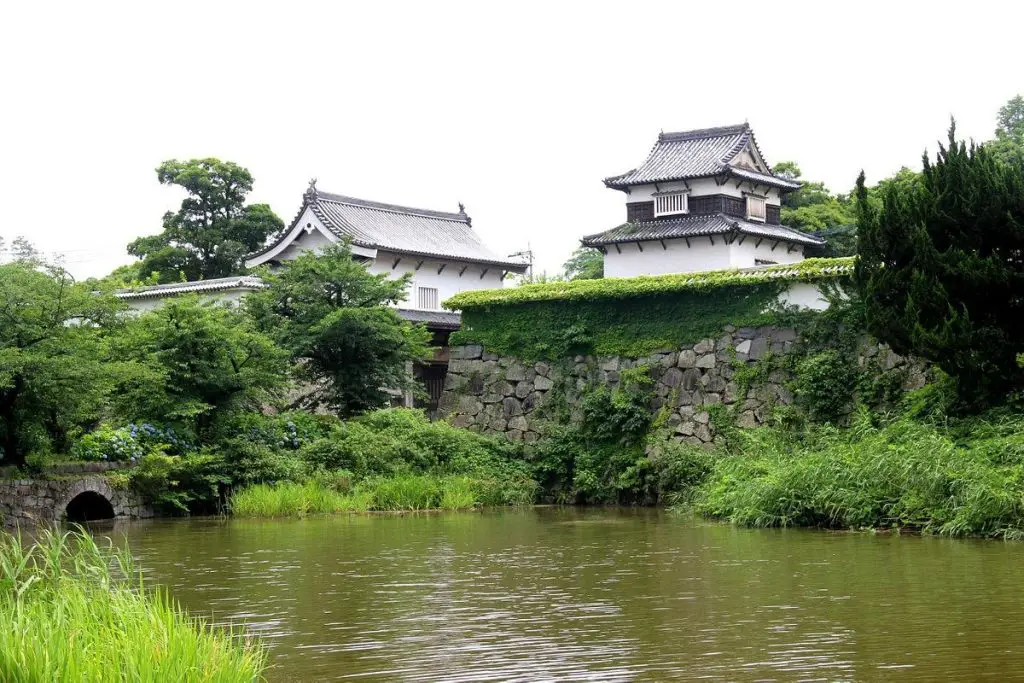
Stepping into Hakata Old Town is like stepping back in time. (Source: Internet)
The area is also known for its traditional craft shops, where you can find handmade pottery, textiles, and other local handicrafts. Take a leisurely stroll through this neighborhood, soak in its nostalgic ambiance, and discover hidden gems around every corner.
2. Yanagibashi Rengo Market
If you’re a fan of food and want to experience a bustling local market, Yanagibashi Rengo Market is a must-visit. This lively market has been operating for over a century and offers a vibrant glimpse into Fukuoka’s culinary scene. Here, you’ll find an abundance of fresh seafood, colorful produce, and a wide array of local ingredients.
Take your time to explore the stalls, interact with the friendly vendors, and sample some of the mouth watering street food. It’s an excellent opportunity to try regional delicacies and witness the daily hustle and bustle of Fukuoka’s local food culture.
When visiting Hakata Old Town and Yanagibashi Rengo Market, there is no specific entrance fee. These areas are open to the public, allowing you to freely wander and soak up the authentic atmosphere. However, do keep in mind that individual shops and restaurants within these neighborhoods may have their own prices for goods and services.
You can also like:
- Things To Do In Ueno: Exciting museums, cherry blossom viewing spot and more
- Best Things To Do In Roppongi: Shopping, Nightlife, Art Museums And More
- Japanese Sauna Culture – Why Saunas Are So Popular in Japan
Immerse yourself in the traditions, flavors, and local life of Fukuoka by exploring these traditional neighborhoods. They offer a glimpse into the city’s rich history, cultural heritage, and vibrant culinary scene that is sure to leave a lasting impression on your journey.
Note: Remember to bring cash with you, as some smaller shops and vendors may not accept credit cards. Exploring these areas allows you to soak up the local culture, try delicious foods, and appreciate the historical charm without the burden of entrance fees.
Experience the vibrant atmosphere of the Asian Art Museum and Fukuoka City Museum
Immerse yourself in the vibrant art and cultural scene of Fukuoka by visiting the Asian Art Museum and Fukuoka City Museum. These two institutions offer unique insights into the rich heritage and artistic traditions of the region.
1. Asian Art Museum
Located in Fukuoka’s bustling Tenjin district, the Asian Art Museum showcases an extensive collection of art and artifacts from various Asian cultures. The museum features works spanning thousands of years, including paintings, sculptures, ceramics, textiles, and more. As you explore the galleries, you’ll encounter masterpieces that highlight the diverse artistic expressions of Asia.
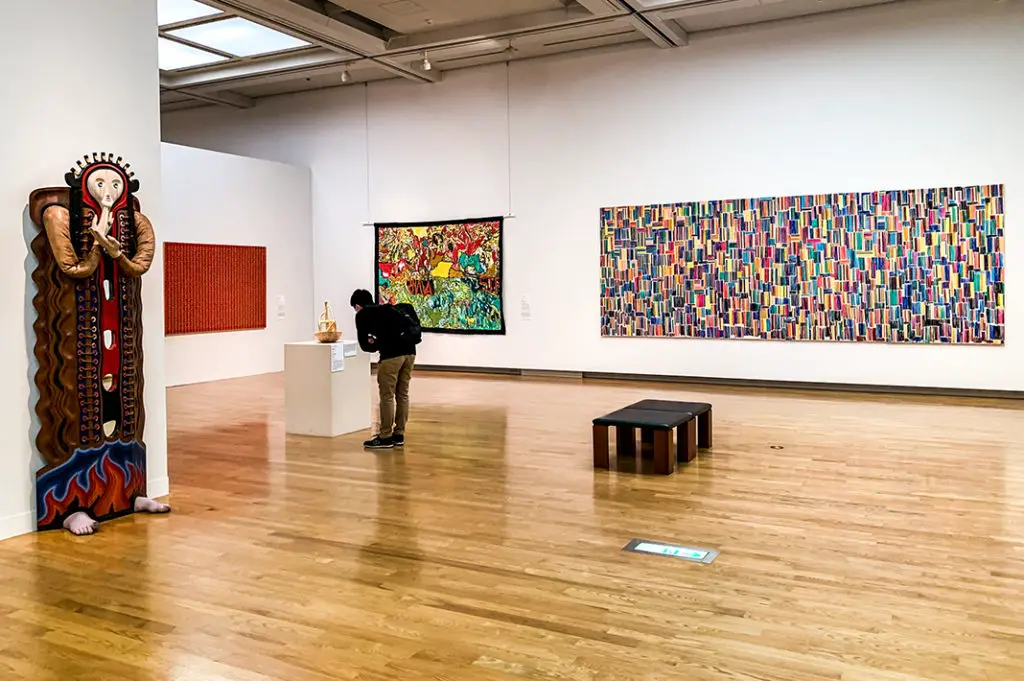
Located in Fukuoka’s bustling Tenjin district, the Asian Art Museum showcases an extensive collection of art and artifacts from various Asian cultures. (Source: Internet)
From traditional Japanese paintings to intricate Buddhist sculptures and contemporary installations, the museum provides a fascinating journey through the artistic legacy of the continent. The entrance fee for the Asian Art Museum is typically around 200 yen ∼ 1,41 USD for adults, with discounts available for students and seniors.
2. Fukuoka City Museum
Situated in the heart of Fukuoka, the Fukuoka City Museum offers a comprehensive look into the history, culture, and development of the city. Through its exhibits and interactive displays, the museum tells the story of Fukuoka from ancient times to the present day. Discover archaeological artifacts, historical documents, and immersive reconstructions that shed light on the city’s past.
Learn about Fukuoka’s role as a cultural hub, its connection to neighboring countries, and its evolution as a modern metropolis. The entrance fee for the Fukuoka City Museum is typically around 200 yen ∼ 1,41 USD for adults, with discounted rates for students and seniors.
Both the Asian Art Museum and Fukuoka City Museum provide a fascinating opportunity to delve deeper into the art, history, and culture of the region. The vibrant collections and engaging exhibitions offer a captivating glimpse into Fukuoka’s cultural identity.
Culinary Delights
Indulge in local specialties like Hakata ramen and motsunabe
When visiting Fukuoka, be sure to indulge in some of the city’s renowned local specialties, including Hakata ramen and motsunabe. These dishes offer a delightful culinary experience that showcases the unique flavors of the region.
1. Hakata Ramen
Fukuoka is famous for its Hakata-style ramen, a beloved dish among locals and visitors alike. This particular style of ramen features thin, straight noodles in a rich and savory pork bone broth known as tonkotsu. The broth is simmered for hours to achieve a creamy and flavorful base.
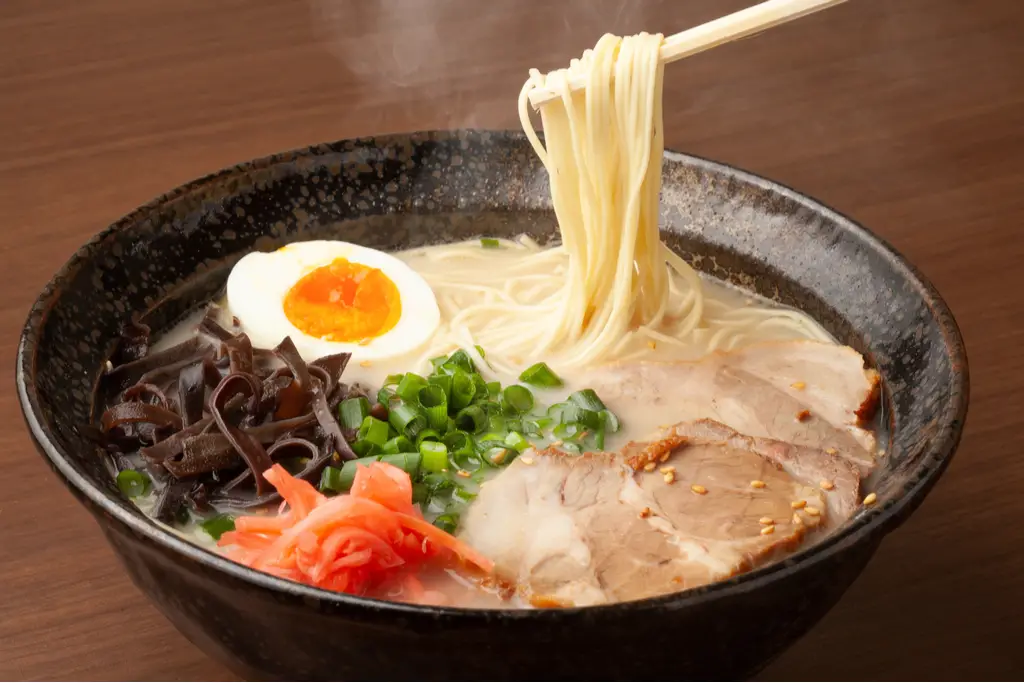
Fukuoka is famous for its Hakata-style ramen, a beloved dish among locals and visitors alike. (Source: Internet)
Topped with slices of tender chashu pork, green onions, and other optional toppings, Hakata ramen is a comforting and satisfying meal. You can find numerous ramen shops throughout Fukuoka, each with its own take on this iconic dish. Don’t miss the opportunity to slurp your way through a bowl of authentic Hakata ramen during your visit.
2. Motsunabe
Motsunabe is a hot pot dish that originated in Fukuoka and is beloved by locals. It features beef or pork offal, known as “motsu,” cooked in a savory broth along with vegetables, tofu, and other ingredients. The rich and hearty flavors make motsunabe a popular choice, especially during the colder months.
The dish is often enjoyed with a dipping sauce or a squeeze of citrus for added zing. Motsunabe is not only a delicious meal but also an opportunity to experience the local Fukuoka food culture. When indulging in these local specialties, the prices can vary depending on the establishment you visit. Ramen shops and restaurants serving motsunabe will have their own pricing structure.
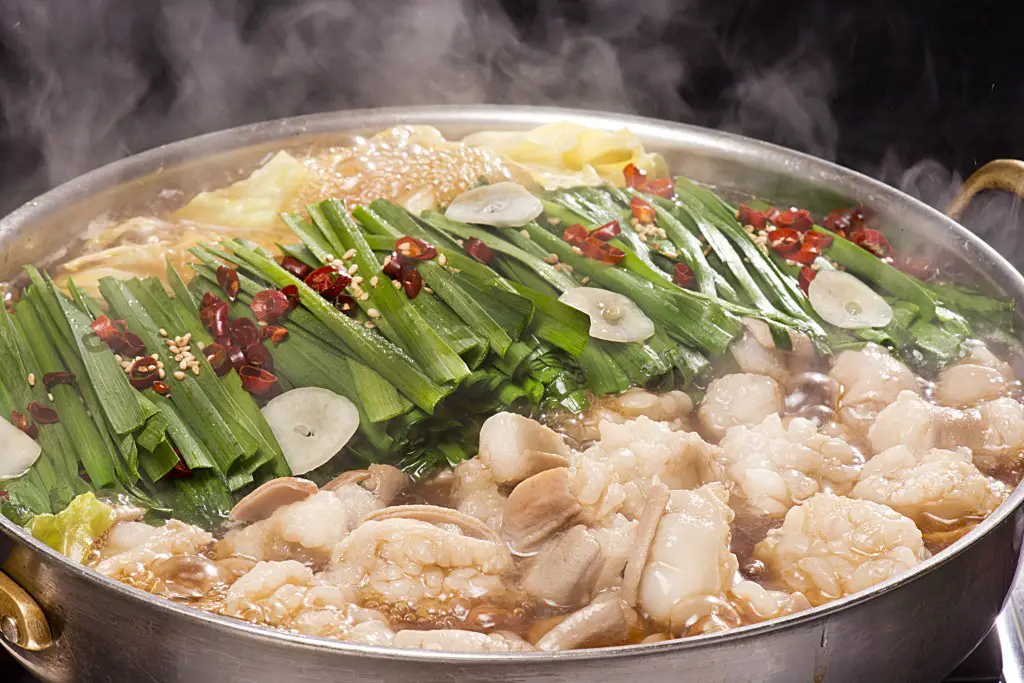
Motsunabe is a hot pot dish that originated in Fukuoka and is beloved by locals. (Source: Internet)
On average, a bowl of Hakata ramen can cost between 600 yen ∼ 4,23 USD to 1,200 yen ∼ 8,47 USD, while a motsunabe meal can range from 2,000 yen ∼ 14,11 USD to 4,000 yen ∼ 28,23 USD per person. However, keep in mind that these prices are estimates and can vary depending on the restaurant’s location, reputation, and additional toppings or ingredients.
Discover the lively food stalls at Nakasu Yatai Street
When in Fukuoka, one culinary experience not to be missed is a visit to Nakasu Yatai Street. This vibrant and bustling street is famous for its yatai, traditional food stalls that offer a wide array of mouthwatering dishes. Here, you can immerse yourself in the lively atmosphere, interact with friendly locals, and indulge in some of Fukuoka’s most delicious street food.
Nakasu Yatai Street is located in the Nakasu area, near the riverbanks of the Naka River. The street comes alive in the evening, with the yatai setting up their stalls and lighting up the night with their colorful lanterns. These cozy and compact stalls provide an intimate dining experience, where you can sit around the counter and watch as the skilled vendors prepare your food right before your eyes.
The food options at Nakasu Yatai Street are diverse, catering to various tastes and preferences. Some popular dishes to try include:
- Hakata-style Yakitori: Skewers of grilled chicken or other ingredients, marinated and cooked to perfection.
- Hakata Mentai Tamago: Grilled cod roe (mentaiko) mixed with eggs and served on a bed of rice. It’s a flavorful and satisfying dish.
- Ramen: Some yatai stalls also serve Hakata-style ramen, allowing you to enjoy this iconic dish in an open-air setting.
- Tempura: Crispy and golden-brown tempura, featuring a variety of ingredients such as shrimp, vegetables, and seafood.
- Oden: A winter favorite, oden is a hot pot dish with various ingredients like boiled eggs, tofu, and vegetables simmered in a flavorful broth.
The prices at Nakasu Yatai Street can vary depending on the specific dish and stall you choose. Generally, the prices range from a few hundred yen to around 1,000 yen ∼ 7,06 USD per dish. It’s advisable to bring cash with you, as most yatai stalls may not accept credit cards.
Experience a traditional tea ceremony and try matcha sweets
Immerse yourself in the tranquility and elegance of Japanese tea culture by experiencing a traditional tea ceremony and indulging in matcha sweets. This centuries-old practice offers a unique opportunity to appreciate the artistry, mindfulness, and flavors associated with tea.
1. Traditional Tea Ceremony
Fukuoka offers various venues where you can participate in a traditional Japanese tea ceremony, known as “chado” or “sado”. These ceremonies are often held in tea houses or dedicated tea rooms and are conducted by knowledgeable tea masters. During the ceremony, you will witness the precise rituals of preparing and serving matcha, a finely powdered green tea.
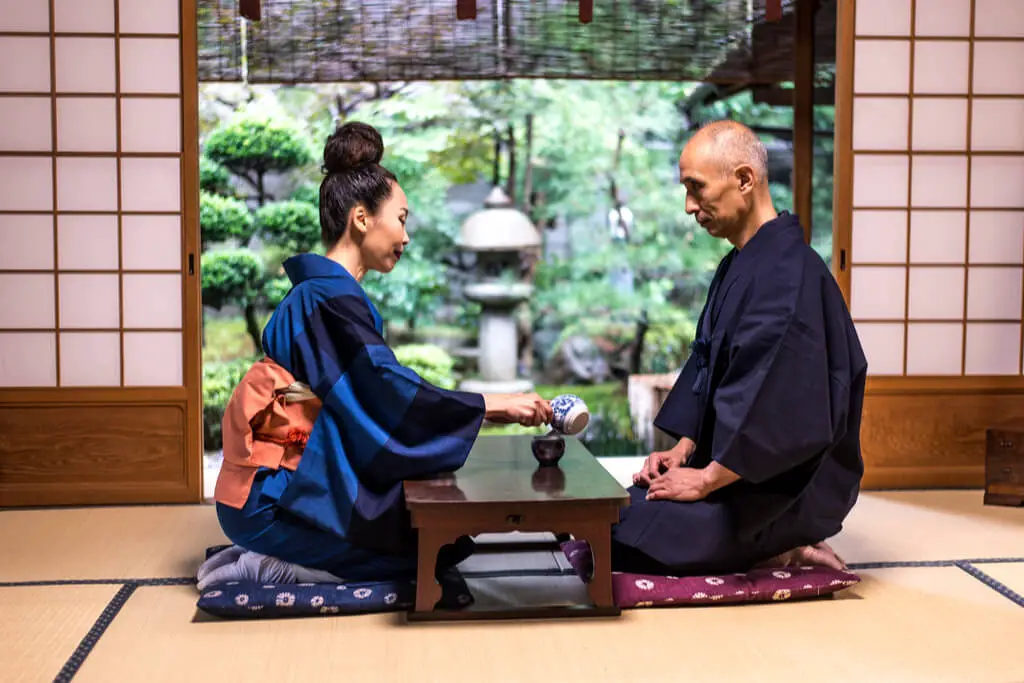
Fukuoka offers various venues where you can participate in a traditional Japanese tea ceremony, known as “chado” or “sado.” (Source: Internet)
The tea master will demonstrate the traditional way of whisking the tea, and you’ll have the chance to savor the carefully prepared matcha. The tea ceremony embodies harmony, respect, and tranquility, providing a glimpse into the deep cultural significance of tea in Japan.
2. Matcha Sweets
Matcha is not only enjoyed as a beverage but also used as an ingredient in a variety of delectable sweets. Fukuoka offers numerous shops and cafes where you can savor matcha-flavored desserts and treats. From delicate matcha-flavored mochi (rice cakes) to rich matcha parfaits, you’ll find a wide range of options to satisfy your sweet tooth.
Matcha-flavored ice cream, cakes, cookies, and traditional Japanese wagashi (sweets) are also popular choices. These matcha-infused delicacies beautifully showcase the distinctive flavor profile of matcha, with its earthy and slightly bitter notes.
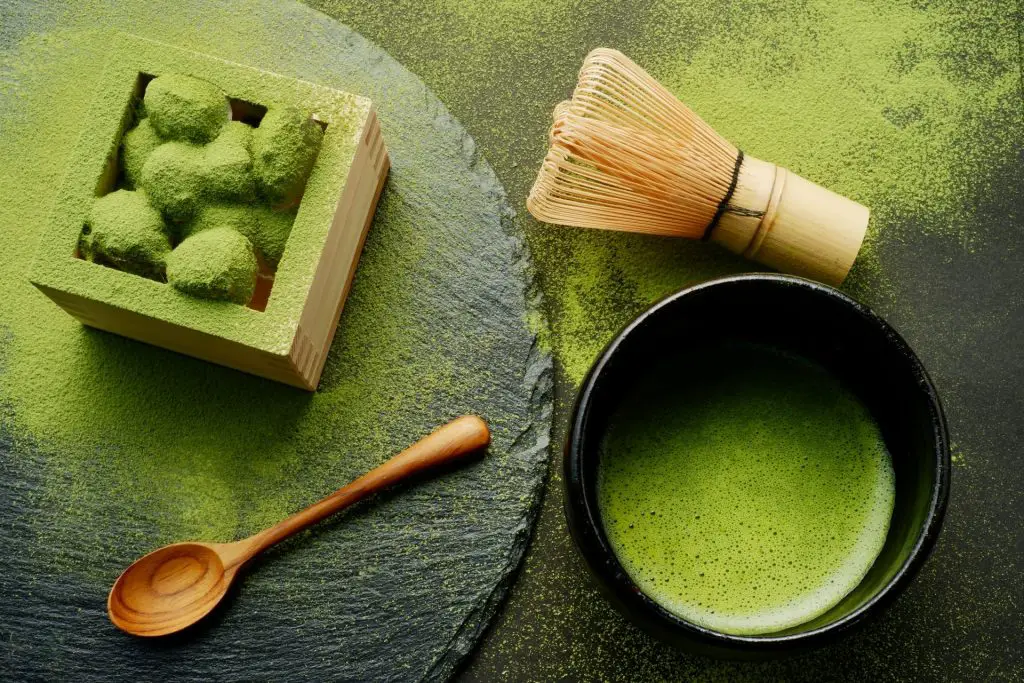
Matcha is not only enjoyed as a beverage but also used as an ingredient in a variety of delectable sweets. (Source: Internet)
The prices for experiencing a traditional tea ceremony can vary depending on the venue, the level of formality, and any additional services provided. It’s recommended to check with tea houses, cultural centers, or traditional gardens in Fukuoka for specific details on tea ceremony experiences and associated costs.
As for matcha sweets, the prices will vary depending on the establishment and the specific item you choose. On average, matcha desserts can range from a few hundred yen to around 1,000 yen ∼ 7,06 USD per serving, depending on the complexity and presentation of the sweet.
Natural Beauty and Outdoor Adventures
Relax in the tranquil surroundings of Ohori Park and Maizuru Park
When visiting Fukuoka, take a break from the bustling city and unwind in the tranquil surroundings of Ohori Park and Maizuru Park. These two green spaces offer a serene retreat where you can relax, enjoy nature, and soak up the peaceful ambiance.
1. Ohori Park
Located in the heart of Fukuoka, Ohori Park is a large, scenic park surrounding a picturesque lake. The park features walking paths that meander around the lake, inviting you to take a leisurely stroll and admire the beauty of the surroundings.
Lush greenery, cherry blossom trees, and vibrant flowers create a refreshing atmosphere throughout the year. You can rent a paddleboat and leisurely glide across the lake’s calm waters or find a peaceful spot to sit and enjoy a picnic. Ohori Park is an ideal place to escape the city noise and find serenity amidst nature.
2. Maizuru Park
Situated near Fukuoka Castle, Maizuru Park offers not only natural beauty but also a historical touch. This park is known for its expansive lawns, carefully manicured gardens, and a peaceful atmosphere. It’s an excellent spot for a leisurely walk or a quiet moment of contemplation.
Maizuru Park also houses remnants of Fukuoka Castle, including stone walls and a watchtower, which add a historical charm to the surroundings. During the cherry blossom season, the park becomes a popular spot for hanami (flower viewing) as the cherry trees burst into vibrant pink hues. It’s a wonderful place to immerse yourself in nature while appreciating Fukuoka’s rich history.
Both Ohori Park and Maizuru Park are open to the public, and there is no specific entrance fee to enjoy their natural beauty. You can simply enter the parks and explore at your leisure. However, certain facilities within the parks, such as boat rentals at Ohori Park, may have separate charges. It’s always a good idea to check for any specific fees or rental costs before participating in additional activities.
Take a scenic boat ride along the Yanagawa River
Embark on a picturesque boat ride along the Yanagawa River and immerse yourself in the natural beauty of the surrounding landscape. Located in the city of Yanagawa, just a short distance from Fukuoka, this tranquil river offers a unique and peaceful experience for visitors.
1. Yanagawa River
The Yanagawa River is a network of canals that wind through the charming city of Yanagawa. The boat ride takes you along these scenic waterways, passing under picturesque bridges and through beautiful countryside scenery. The calm and gentle flow of the river creates a soothing atmosphere, allowing you to relax and enjoy the surrounding nature.
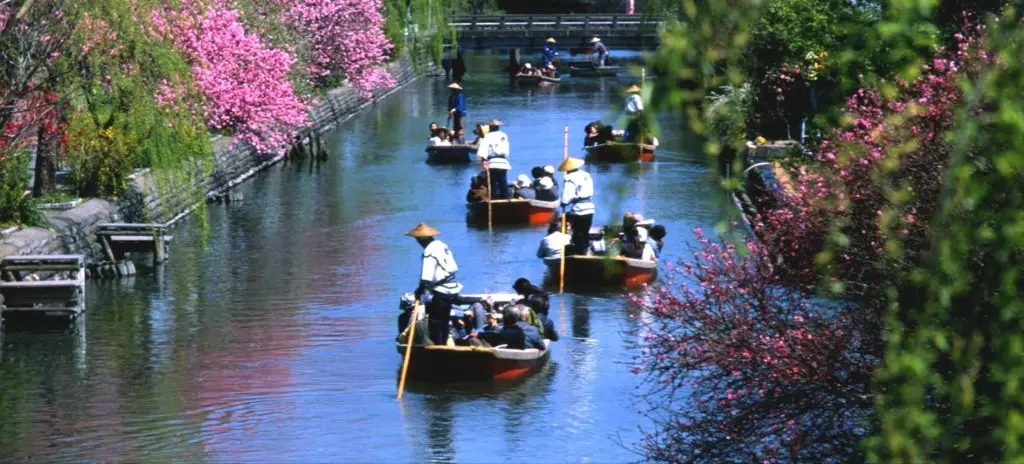
The Yanagawa River is a network of canals that wind through the charming city of Yanagawa. (Source: Internet)
2. Traditional Donkobune Boat
The boat ride is typically conducted on a traditional donkobune boat, which is a flat-bottomed boat propelled by a boatman using a long pole. These boats are designed to navigate the shallow waters of the canals and provide a unique and authentic experience.
You can sit back and enjoy the tranquil ride while the boatman expertly navigates the river, sharing interesting stories and historical facts about the area.
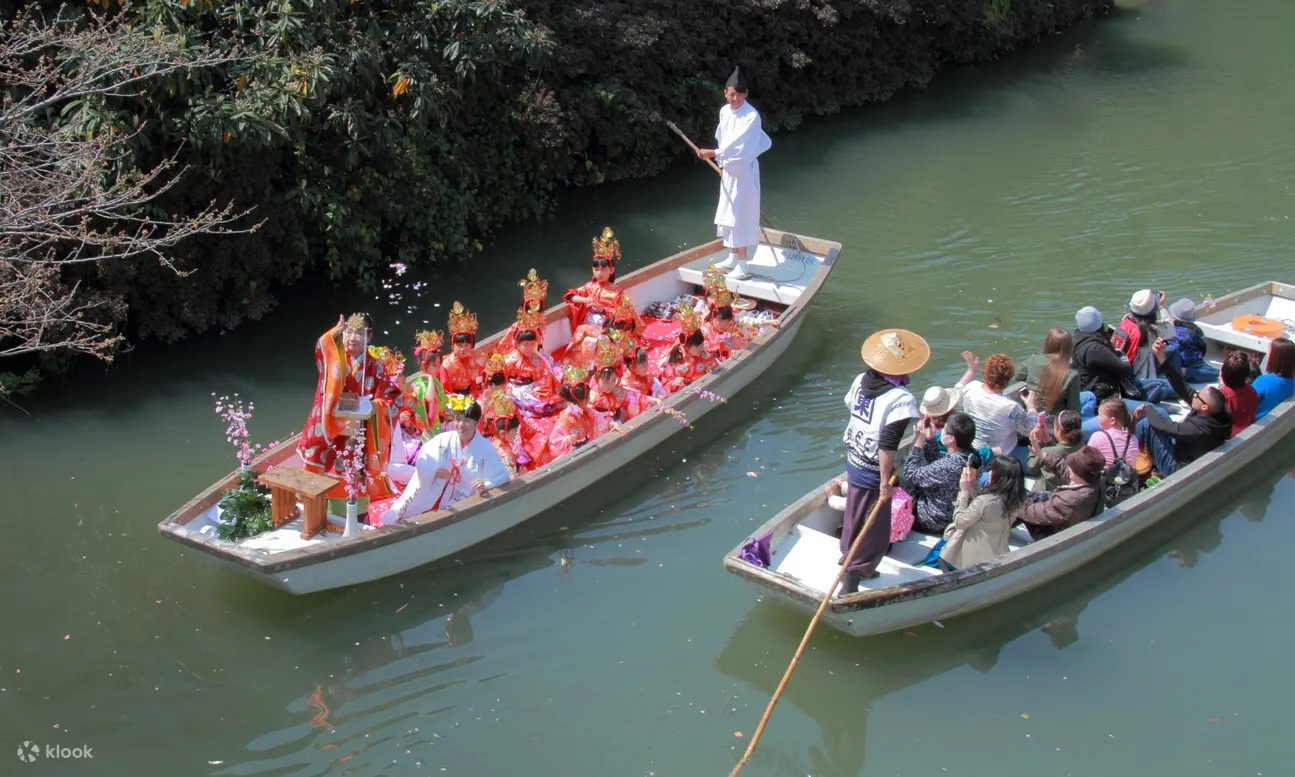
The boat ride is typically conducted on a traditional donkobune boat, which is a flat-bottomed boat propelled by a boatman using a long pole. (Source: Internet)
3. Scenic Views and Landmarks
As you glide along the river, you’ll be treated to breathtaking views of the countryside, lush greenery, and traditional Japanese houses lining the riverbanks. You may also pass by notable landmarks such as historic buildings, temples, and shrines, which add cultural richness to the journey. Keep an eye out for beautiful seasonal flowers and foliage, as the scenery changes throughout the year.
The cost of the boat ride along the Yanagawa River may vary depending on the specific boat company and the duration of the ride. Generally, the prices range from around 1,000 yen ∼ 7,06 USD to 2,000 yen ∼ 14,11 USD per person for a standard 30 to 60-minute boat ride. It’s recommended to check with the boat companies in Yanagawa for up-to-date pricing and availability.
A boat ride along the Yanagawa River offers a peaceful and scenic escape, allowing you to appreciate the beauty of the region and immerse yourself in its rich cultural heritage. It’s a wonderful way to connect with nature, learn about the local history, and create lasting memories of your time in Fukuoka.
Explore the stunning beaches and hot springs of Itoshima Peninsula
Discover the natural beauty and relaxation of Itoshima Peninsula, known for its stunning beaches and rejuvenating hot springs. Located just west of Fukuoka City, this coastal region offers a perfect retreat from the urban hustle and bustle.
1. Beaches
Itoshima Peninsula boasts a number of beautiful beaches along its coastline. From sandy shores to rocky cliffs, there is a beach for every preference. Futamigaura Beach is particularly renowned for its iconic “Meoto Iwa” (Wedded Rocks), which are two large rocks connected by a shimenawa rope. The beach offers a picturesque setting for a leisurely stroll or to simply soak up the sun.
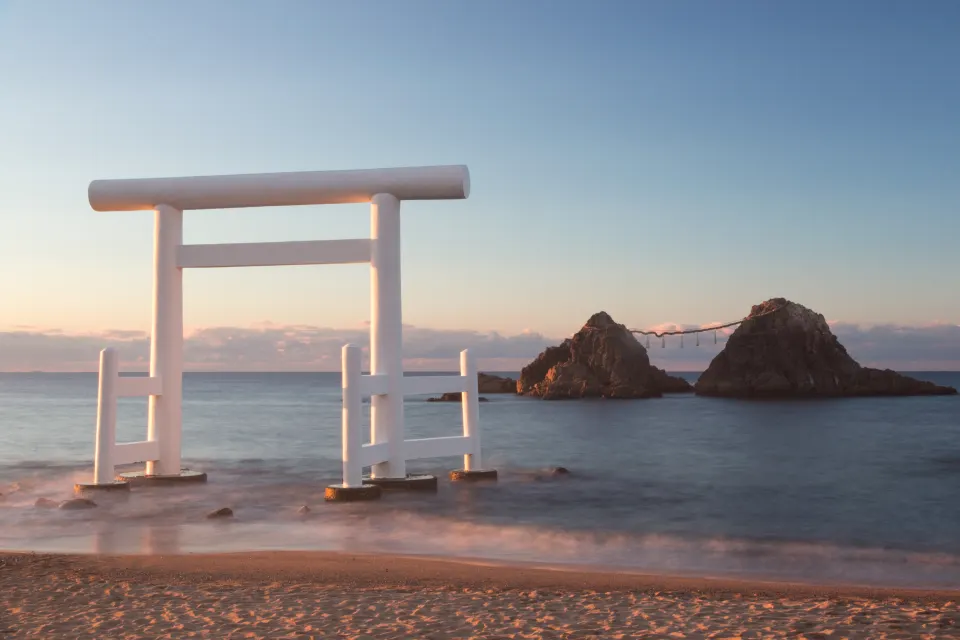
toshima Peninsula boasts a number of beautiful beaches along its coastline. (Source: Internet)
Other notable beaches include Sakurai Futamigaura Beach, Keya Beach, and Maebaru Sun Beach. Whether you’re looking to swim, sunbathe, or enjoy water sports, the beaches of Itoshima Peninsula offer a scenic backdrop for relaxation and enjoyment.
2. Hot Springs
After a day of beach exploration, indulge in the soothing and therapeutic hot springs (onsen) that dot the Itoshima Peninsula. The region is known for its abundance of natural hot springs, where you can immerse yourself in the rejuvenating mineral-rich waters.
Many hot spring resorts and ryokans offer a range of bathing options, including indoor and outdoor baths, each with its own unique ambiance and views. The hot springs provide an opportunity to unwind, release stress, and experience a traditional Japanese wellness practice.
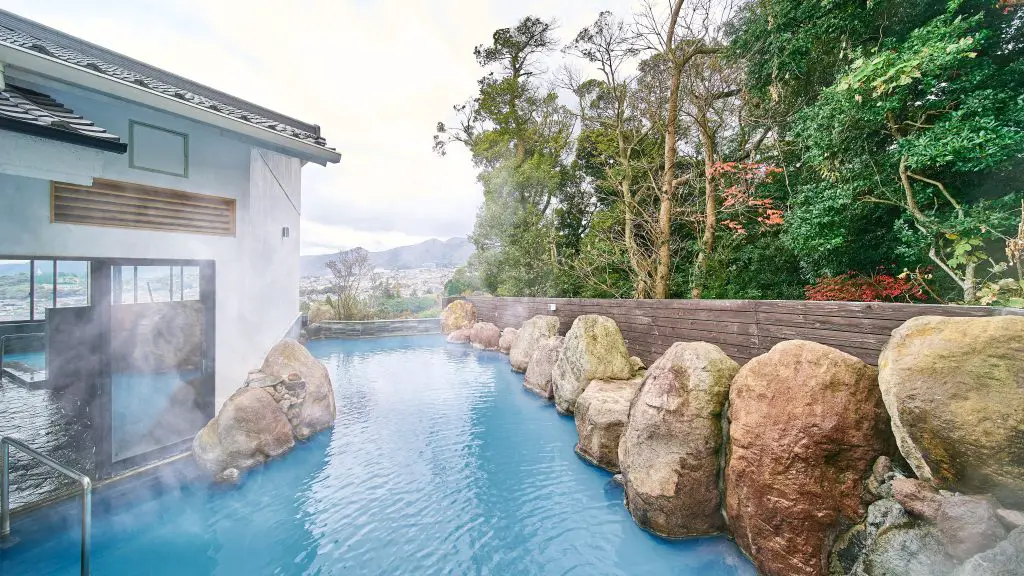
After a day of beach exploration, indulge in the soothing and therapeutic hot springs (onsen) that dot the Itoshima Peninsula. (Source: Internet)
The prices for visiting the beaches of Itoshima Peninsula are generally free, with public access to the shoreline. However, certain beaches may have parking fees or facilities that require a fee, such as rental equipment or beachside cafes. It’s recommended to check for any specific charges before your visit.
As for the hot springs, prices will vary depending on the onsen facility and the services offered. Day-use fees typically range from around 500 yen ∼ 3,53 USD to 1,500 yen ∼ 10,58 USD per person. If you choose to stay at a hot spring resort or ryokan, overnight rates will depend on the accommodations you select. It’s advisable to check with the specific hot spring establishments for accurate pricing and availability.
Shopping and Entertainment
Shop for unique souvenirs at Canal City Hakata and Tenjin Underground Shopping Mall
Indulge in a shopping spree and find unique souvenirs at two popular shopping destinations in Fukuoka: Canal City Hakata and Tenjin Underground Shopping Mall.
1. Canal City Hakata
Located in the vibrant Hakata district, Canal City Hakata is a vast shopping and entertainment complex that offers a diverse range of shops, boutiques, and entertainment options. The complex features a unique design with a central canal running through it, creating a lively atmosphere. Here, you can explore a variety of stores offering fashion, accessories, cosmetics, electronics, and more.
From trendy international brands to local specialty shops, Canal City Hakata offers a wide selection of items to suit different tastes and preferences. Additionally, you’ll find a range of dining options, including restaurants serving local cuisine and international flavors, making it a one-stop destination for shopping and dining.
2. Tenjin Underground Shopping Mall
Situated beneath the bustling Tenjin district, the Tenjin Underground Shopping Mall is a vast underground network of shops and boutiques. This subterranean shopping paradise offers a respite from the city streets and allows you to explore a wide range of stores conveniently located in one area.
You’ll find an array of shops selling fashion, accessories, cosmetics, traditional Japanese crafts, souvenirs, and much more. The underground mall also provides easy access to department stores and shopping centers in the surrounding area. It’s an ideal place to discover unique souvenirs and shop for both traditional and modern items.
The prices of items at Canal City Hakata and Tenjin Underground Shopping Mall can vary depending on the specific stores and products. Both locations offer a range of price points to cater to different budgets. You’ll find high-end luxury brands as well as more affordable options. It’s worth exploring different stores and comparing prices to find the best deals and souvenirs that fit your preferences.
Experience the lively nightlife in the Nakasu entertainment district
Immerse yourself in the vibrant nightlife of Fukuoka by exploring the Nakasu entertainment district. Located in the heart of Fukuoka City, Nakasu is renowned for its bustling streets, vibrant atmosphere, and a wide range of entertainment options. Here’s what you can expect when experiencing the lively nightlife in Nakasu:
1. Izakayas and Bars
Nakasu is home to numerous izakayas (Japanese-style pubs) and bars, making it a perfect place to enjoy drinks, socialize, and sample a variety of Japanese cuisine. From traditional izakayas serving delicious yakitori (grilled skewers) and sake, to trendy bars offering creative cocktails and craft beers, there is something for everyone. You can hop from one establishment to another, soaking up the energetic atmosphere and trying different drinks and dishes along the way.
The prices of drinks and food at izakayas and bars in Nakasu can range from moderate to high, depending on the establishment and the type of drink or dish. Beers and standard cocktails usually start around 500 yen ∼ 3,53 USD to 800 yen ∼ 5,65 USD, while specialty cocktails or high-end drinks may cost more. Food prices can vary, but you can find affordable options like yakitori skewers or small plates for around 300 yen ∼ 2,12 USD to 800 yen ∼ 5,65 USD.
2. Yatai Food Stalls
One of the highlights of Nakasu’s nightlife is the iconic yatai food stalls. These open-air food stalls line the streets of Nakasu, offering a wide selection of mouth watering street food. You can savor local specialties like ramen, yakitori, okonomiyaki, and more, all prepared fresh right in front of you. Grab a seat at one of the stalls, strike up a conversation with fellow diners, and enjoy the lively ambiance of this unique dining experience.
Yatai food stalls are known for their reasonably priced street food. The prices for dishes at yatai stalls can range from around 500 yen ∼ 3,53 USD to 1,500 yen ∼ 10,58 USD per item, depending on the type of food and portion size. It’s a great option for budget-friendly dining while experiencing the lively atmosphere of Nakasu.
3. Clubs and Karaoke
For those seeking a more energetic nightlife scene, Nakasu is home to clubs and karaoke establishments where you can dance, sing, and party the night away. Dance clubs feature a mix of music genres, including J-pop, EDM, and hip-hop, creating a lively and dynamic atmosphere. Karaoke rooms provide a fun and interactive experience where you can showcase your singing talents and enjoy private group gatherings.
Clubs in Nakasu may have cover charges, especially on weekends or for special events. The cover charges can range from around 1,000 yen ∼ 7,06 USD to 3,000 yen ∼ 21,17 USD or more, depending on the venue and the night.
Drinks in clubs may be priced higher compared to bars or izakayas. Karaoke establishments typically charge for room rental, which can vary depending on the size of the room, the duration of the session, and additional services. Prices for karaoke room rental can range from around 1,000 yen ∼ 7,06 USD to 5,000 yen ∼ 35,28 USD per hour or more.
Attend a thrilling baseball game at the Fukuoka Yahuoku! Dome
Experience the excitement of a baseball game by attending a thrilling match at the Fukuoka Yahuoku! Dome. As the home stadium of the Fukuoka SoftBank Hawks, one of Japan’s most successful baseball teams, the dome offers an unforgettable sporting experience. Here’s what you can expect when attending a baseball game at the Fukuoka Yahuoku! Dome:
1. Atmosphere
The Fukuoka Yahuoku! Dome is known for its lively and passionate atmosphere during baseball games. Fans come together to cheer for their favorite team, creating an electrifying ambiance. From the enthusiastic chants and cheers to the colorful team merchandise and face paint, you’ll be fully immersed in the excitement of Japanese baseball culture.
2. Game Experience
Watching a baseball game at the dome allows you to witness the skills and intensity of professional baseball players up close. From the crack of the bat to the impressive pitching, every moment is filled with anticipation. The Fukuoka SoftBank Hawks have a strong fan base, and their games often feature thrilling plays, home runs, and competitive action that will keep you on the edge of your seat.
3. Food and Refreshments
The Fukuoka Yahuoku! Dome offers a variety of food and beverage options to enhance your game day experience. You can indulge in classic baseball snacks like hot dogs, popcorn, and beer, as well as local specialties and unique stadium fare. The food stalls and concession stands offer a wide selection of delicious treats to satisfy your cravings while enjoying the game.
The prices for attending a baseball game at the Fukuoka Yahuoku! Dome can vary depending on factors such as seating location, game popularity, and the opponent team. Ticket prices generally range from around 1,500 yen ∼ 10,58 USD to 6,000 yen ∼ 42,34 USD or more for regular season games.
Premium seating or special game events may have higher prices. It’s recommended to check the official Fukuoka SoftBank Hawks website or authorized ticket vendors for the most accurate and up-to-date ticket information.
Festivals and Events
Participate in the Hakata Gion Yamakasa festival
Participating in the Hakata Gion Yamakasa festival is an incredible opportunity to immerse yourself in Fukuoka’s vibrant cultural heritage and witness a grand display of tradition and excitement. Here’s what you can expect when joining this iconic festival:
1. Festival Overview
The Hakata Gion Yamakasa festival is held annually in Fukuoka during the month of July. It is a week-long event that culminates in the thrilling Yamakasa race, which takes place on the final day. The festival dates back over 700 years and is deeply rooted in local traditions and beliefs.
2. Yamakasa Race
The highlight of the Hakata Gion Yamakasa festival is the Yamakasa race, where teams of men carry massive wooden floats known as “yamakasa” through the streets of Hakata. Each team represents a different district or neighborhood and competes for the fastest time.
The floats, adorned with colorful decorations, are carried on the shoulders of the participants as they navigate the designated course. The race is filled with energy, as the team’s sprint through the streets, cheered on by enthusiastic crowds.
3. Festive Atmosphere
The festival creates a lively and jubilant atmosphere throughout the city. Streets are decorated with lanterns and banners, and traditional music and chants fill the air. Participants and spectators alike dress in traditional happi coats and yukatas, adding to the festive spirit. Food stalls line the streets, offering a variety of local delicacies and festival treats to savor while enjoying the festivities.
Participating in the Hakata Gion Yamakasa festival is generally free of charge, allowing you to immerse yourself in the celebration without needing to purchase tickets. However, if you wish to witness the Yamakasa race from reserved seating areas or attend certain related events, there may be costs involved. It’s advisable to check the official Hakata Gion Yamakasa festival website or consult local tourism information for specific details, schedules, and any applicable fees.
The Hakata Gion Yamakasa festival is a unique cultural experience that showcases the rich heritage and community spirit of Fukuoka. By joining in the festivities, you’ll witness the passion and dedication of the participants and gain a deeper appreciation for Fukuoka’s cultural traditions.
Enjoy the colorful floats and performances at the Dontaku Port Festival
Enjoying the colorful floats and performances at the Dontaku Port Festival is a fantastic way to immerse yourself in Fukuoka’s vibrant cultural scene. Here’s what you can expect when attending this lively festival:
1. Festival Overview
The Dontaku Port Festival is an annual event held in Fukuoka during Golden Week, usually in early May. It is one of the largest festivals in the city, attracting both locals and visitors alike. The festival celebrates a rich blend of traditional and contemporary culture, showcasing colorful floats, energetic performances, and lively street parades.
2. Float Processions
The highlight of the Dontaku Port Festival is the procession of ornately decorated floats known as “hakata-ori yatai.” These floats are paraded through the streets of Fukuoka, accompanied by traditional music, dance performances, and enthusiastic participants. Each float represents a different theme or aspect of Fukuoka’s heritage, making the procession a visual feast of colors and cultural symbolism.
3. Street Performances
In addition to the float processions, the Dontaku Port Festival features various street performances that take place throughout the festival area. You can enjoy traditional Japanese music, dance, taiko drumming, and other forms of live entertainment performed by local artists. These performances add to the festive atmosphere and provide a glimpse into Fukuoka’s vibrant arts and cultural scene.
Attending the Dontaku Port Festival is generally free of charge, allowing you to experience the floats, performances, and street parades without needing to purchase tickets. However, if you wish to enjoy local food and drinks from the numerous food stalls that line the festival area or purchase festival-related souvenirs, there will be expenses associated with those purchases.
The prices for food, drinks, and merchandise will vary depending on your preferences and the specific vendors present during the festival.
It’s important to note that the Dontaku Port Festival may attract large crowds, especially on weekends and public holidays during Golden Week. It’s advisable to plan your visit accordingly, arrive early to secure a good viewing spot for the float processions, and be prepared for the festive atmosphere and potential waiting times.
By attending the Dontaku Port Festival, you can immerse yourself in Fukuoka’s cultural heritage, witness the beauty of the floats, enjoy captivating performances, and savor the delicious local delicacies offered during this vibrant celebration.
Experience the traditional Japanese art of Noh theater at the Hakata Machiya Folk Museum
Experiencing the traditional Japanese art of Noh theater at the Hakata Machiya Folk Museum is a captivating cultural experience. Here’s what you can expect when attending a Noh theater performance at the museum:
1. Noh Theater and its Significance
Noh is one of the oldest forms of traditional Japanese theater, known for its stylized movements, poetic dialogues, and intricate masks. It combines elements of drama, music, dance, and poetry to portray various stories from folklore, history, and mythology. Noh theater holds great cultural significance, as it embodies the elegance, grace, and profound spirituality of Japanese performing arts.
2. Hakata Machiya Folk Museum
The Hakata Machiya Folk Museum is a historic building that showcases the traditional architecture and lifestyle of Fukuoka’s Hakata district. It serves as a venue for cultural events, including Noh theater performances. The museum provides an intimate and authentic setting for experiencing Noh, allowing you to immerse yourself in the rich cultural heritage of Japan.
3. Noh Performance
During a Noh theater performance, you’ll witness highly skilled actors portraying iconic characters and their emotional journeys. The actors wear elaborate costumes, mesmerizing masks, and perform precise movements accompanied by traditional music and chanting. The atmosphere is serene and captivating, with an emphasis on subtlety, symbolism, and the power of storytelling.
The price of attending a Noh theater performance at the Hakata Machiya Folk Museum may vary depending on the specific event, the performers, and the seating arrangement. It’s advisable to check the museum’s official website or contact them directly for information about upcoming performances, ticket prices, and availability.
Additionally, it’s recommended to book your tickets in advance, as Noh theater performances can be popular among both locals and tourists.
By experiencing Noh theater at the Hakata Machiya Folk Museum, you’ll have the opportunity to delve into the rich cultural heritage of Japan, witness the mastery of Noh performers, and appreciate the timeless beauty of this traditional art form.
Day Trips from Fukuoka
Explore the historic city of Dazaifu and visit Dazaifu Tenmangu Shrine
Exploring the historic city of Dazaifu and visiting Dazaifu Tenmangu Shrine is a must-do experience when in Fukuoka. Here’s what you can expect:
1. Dazaifu
Located about 15 kilometers southeast of Fukuoka city, Dazaifu is a charming historic city that served as the administrative center of Kyushu during the ancient and medieval periods. It boasts a rich cultural heritage, preserved architecture, and tranquil surroundings that offer a glimpse into Japan’s past.
2. Dazaifu Tenmangu Shrine
Dazaifu Tenmangu Shrine is one of Japan’s most revered Shinto shrines and is dedicated to the deity of learning and academic achievement, Sugawara no Michizane. The shrine is known for its beautiful architecture, serene gardens, and vibrant atmosphere. Visitors come here to pray for success in their studies, career, and personal endeavors.
3. Shrine Grounds
Upon entering Dazaifu Tenmangu Shrine, you’ll be greeted by the iconic vermilion torii gate and a pathway lined with shops and stalls selling various souvenirs and local delicacies. As you explore the shrine grounds, you’ll encounter stunning gardens, peaceful ponds, and various smaller shrines and prayer halls. Don’t miss the opportunity to witness traditional rituals and ceremonies if they happen to be taking place during your visit.
Visiting Dazaifu Tenmangu Shrine is generally free of charge, allowing you to explore the shrine grounds and soak in the spiritual atmosphere without needing to purchase tickets. However, there may be small fees for specific activities or attractions within the shrine complex, such as entering certain exhibition halls or participating in cultural events. These fees, if applicable, are usually nominal.
Apart from the shrine, Dazaifu offers other attractions worth exploring, such as Kyushu National Museum, Komyozenji Temple, and the scenic Kashiida-gawa River. The city is also known for its traditional sweets and snacks, so be sure to indulge in some local treats during your visit.
Take a ferry to Nokonoshima Island for beautiful gardens and outdoor activities
Taking a ferry to Nokonoshima Island is a wonderful way to escape the hustle and bustle of Fukuoka and immerse yourself in nature. Here’s what you can look forward to when visiting Nokonoshima Island:
- Ferry Ride: The journey to Nokonoshima Island begins with a scenic ferry ride from Meinohama Ferry Terminal in Fukuoka. The ferry ride itself offers breathtaking views of the surrounding coastline and the picturesque scenery of the area.
- Beautiful Gardens: Nokonoshima Island is renowned for its stunning gardens, which bloom with vibrant flowers throughout the year. The island boasts a variety of gardens, including the famous Nokonoshima Island Park. Here, you can stroll through beautifully landscaped gardens, enjoy the sight and scent of blooming flowers, and relax in peaceful natural surroundings.
- Outdoor Activities: Nokonoshima Island offers a range of outdoor activities for nature enthusiasts. You can take leisurely walks along the island’s walking trails, rent bicycles to explore the scenic landscapes, or enjoy a picnic with a view of the ocean. The island also has recreational facilities such as a mini-golf course and a playground, making it a great destination for families as well.
When it comes to pricing, here are some considerations:
- Ferry Tickets: The cost of ferry tickets to Nokonoshima Island varies depending on the season and the age of the passenger. It’s recommended to check the official ferry company’s website or inquire at the Meinohama Ferry Terminal for up-to-date pricing information.
- Garden Admission: There is an admission fee to enter Nokonoshima Island Park, which includes access to the gardens and other facilities on the island. The admission fee is typically reasonable and offers great value for the experience and beauty of the gardens.
Overall, visiting Nokonoshima Island provides a serene and picturesque getaway, where you can immerse yourself in the natural beauty of the gardens, enjoy outdoor activities, and rejuvenate in a tranquil environment away from the city.
Discover the ancient ruins of the Yoshinogari Historical Park in Saga Prefecture
Discovering the ancient ruins of the Yoshinogari Historical Park in Saga Prefecture is like stepping back in time to Japan’s ancient past. Here’s what you can expect when visiting Yoshinogari Historical Park:
- Ancient Ruins: Yoshinogari Historical Park is an archaeological site that dates back to the Yayoi period, which lasted from approximately 300 BCE to 300 CE. The park covers a vast area and contains the remains of a large Yayoi period settlement. As you explore the park, you’ll come across reconstructed ancient dwellings, moats, rice paddies, and defensive structures, providing a fascinating glimpse into the daily life and culture of the Yayoi people.
- Exhibitions and Museums: The park features several exhibition halls and museums where you can learn more about the history and artifacts unearthed at the site. The Yoshinogari Museum houses a collection of excavated artifacts, including pottery, tools, and personal items, allowing you to gain a deeper understanding of the Yayoi period and the people who inhabited the area.
- Hands-on Activities: Yoshinogari Historical Park offers various hands-on activities that allow you to experience aspects of Yayoi culture firsthand. You can try your hand at traditional crafts, such as pottery making or weaving, or participate in workshops and demonstrations that showcase ancient techniques and skills.
When it comes to pricing, here are some considerations:
- Park Admission: There is an admission fee to enter Yoshinogari Historical Park, which grants you access to the park grounds, reconstructed dwellings, exhibitions, and museums. The admission fee is typically reasonable and varies depending on age and whether you visit during the regular season or special events. It’s recommended to check the official website or contact the park for up-to-date pricing information.
Yoshinogari Historical Park offers a unique opportunity to explore ancient history and gain insights into Japan’s rich cultural heritage. It’s a place where you can immerse yourself in the archaeological wonders of the Yayoi period and gain a deeper appreciation for the early civilizations that shaped Japan.
How to get to these places?
There are several ways to get to Fukuoka, depending on your location and preference. Here are some common transportation options:
- By Air: Fukuoka is served by Fukuoka Airport (FUK), which is one of Japan’s major airports with domestic and international flights. You can check for direct flights to Fukuoka from your location or connect through other major airports in Japan. Once you arrive at Fukuoka Airport, you can easily access the city center by subway or bus.
- By Train: Fukuoka is well-connected to other major cities in Japan by train. If you are traveling from Tokyo, Osaka, or other parts of the country, you can take the Shinkansen (bullet train) to Hakata Station, which is the main train station in Fukuoka. The journey by Shinkansen is fast, comfortable, and offers scenic views along the way. From Hakata Station, you can easily reach your desired destination within Fukuoka by subway, bus, or taxi.
- By Bus: Long-distance buses are another option for reaching Fukuoka. Japan has an extensive network of highway buses that connect various cities. Bus travel can be a more affordable option compared to trains or flights, and there are overnight buses available for longer journeys.
- By Ferry: If you are traveling from nearby islands or countries, there are ferry services available to Fukuoka. Fukuoka International Ferry Terminal is located near the city center and offers connections to destinations such as South Korea and China.
Once you arrive in Fukuoka, the city has a well-developed public transportation system, including subways, buses, and taxis, making it easy to navigate and reach your desired destinations within the city.
It’s recommended to check the schedules, availability, and fares for your chosen mode of transportation in advance, especially during peak travel seasons. Booking tickets in advance, particularly for flights and Shinkansen trains, can help ensure a smooth journey to Fukuoka.
FAQs
1. What is the main draw of Fukuoka?
Some of Japan’s best dining, shopping, and nightlife can be found in Fukuoka city. It is one of the best cities in Japan to live in or simply visit due to its accessibility to fantastic beaches, a range of natural features, and the rich cultural and historical legacy of Kyushu as a whole.
2. How long is enough for Fukuoka?
Planning an itinerary for one day, three days, or even five days in Fukuoka is not too difficult. When visiting Fukuoka, allow one to two days and make travel arrangements to neighboring interesting locations. If you intend to travel throughout JR Kyushu from Fukuoka, we strongly advise that you get the JR Kyushu Pass.
3. Does Fukuoka welcome foreigners?
You’ll appreciate Fukuoka’s openness as a visitor because it contrasts well with Japan’s closed-off culture. Due to the city’s inclusive and diverse culture, you’ll generally find it easier to adjust and feel as though the city is doing the same for you.
4. Which time of year is ideal for Fukuoka?
No matter the season, you should have a good time, but the greatest seasons to visit Fukuoka are usually in the spring and the fall. DEC-FEB: Fukuoka and the rest of Kyushu are warmer than other regions of Japan because of their southern location.
5. Does Fukuoka get any snow?
In contrast to most cities along the Sea of Japan, Fukuoka City experiences nearly no snowfall throughout the winter months. Instead, there aren’t many sunny days, and the days are frequently gloomy and foggy.
6. Which month gets the coldest in Fukuoka?
In Fukuoka, January is the coldest month. The weather can be a little challenging because of the seasonal winds and the brief window of daylight. The temperature ranges between highs of 10°C (50°F) to lows of 4°C (39°F), with an average of about 7°C (about 45°F).
7. Is Fukuoka costly?
Fukuoka, Japan, cost of living summary: Without rent, the projected monthly expenses for a family of four are 3,252.8 dollars (460,415.8 yen). Without rent, a single person’s projected monthly expenses is 921.3$ (130,399.3 yen).
8. How much is the bullet train from Fukuoka to Osaka?
Between 2 hours 21 and 2 hours 28 are needed to go by rail from Fukuoka to Osaka. How much does the bullet train cost between Fukuoka and Osaka? Depending on the type of service, the number of reserved seats, and the amount of time you book them in advance, Fukuoka to Osaka Shinkansen tickets typically cost around 158 USD.
9. Can I drink Fukuoka’s tap water?
In Japan, drinking water straight from the tap is safe. When visiting Japan, try to utilize a reusable water bottle rather than purchasing bottled water to save the environment. Although there are water fountains in metro train stations, it can be difficult to find them elsewhere (this is the country of vending machines, after all).
10. Does Fukuoka have cherry blossoms?
There are more than a thousand cherry blossoms growing on the Fukuoka Castle Ruins.
Conclusion
In conclusion, Fukuoka offers a captivating array of activities and attractions that cater to every traveler’s interests. From its rich historical landmarks to its modern shopping districts, the city seamlessly blends tradition with innovation, creating a truly unique experience.
So pack your bags, immerse yourself in the captivating blend of tradition and modernity, and embark on an unforgettable journey through the vibrant streets of Fukuoka. Discover things to do in Kukuoka which is the city’s hidden gems, embrace its unique charm, and create lasting memories that will stay with you long after your visit.

